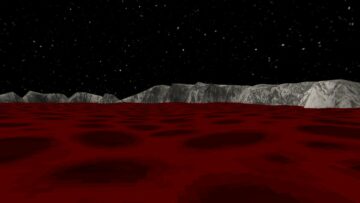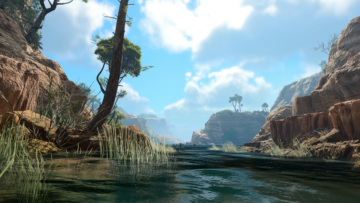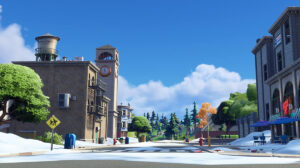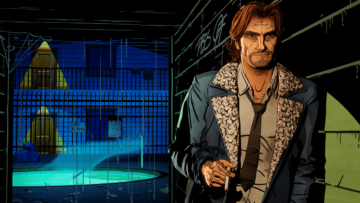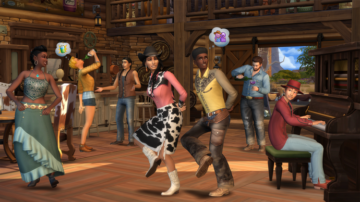Expectations are enormous for Bethesda’s latest title, Starfield. It promises a galaxy-spanning adventure with a wealth of content and hundreds of planets to explore. Few games come anywhere near this kind of scope – and fewer still come with the high level of content quality and gameplay flexibility that Bethesda typically offers. But that’s not to say there haven’t been concerns. Top of mind are technical worries, with prospective players perturbed by the potential for bugs and frame-rate hiccups. Bethesda’s prior console efforts haven’t always arrived in stable form, and those games were orders of magnitude smaller than Starfield. The key question for many is this: is Starfield good to go at launch, or should you wait for performance issues and bugs to be resolved?
There are other key concerns too. For example, what’s the story with Xbox Series S? Microsoft’s junior machine has been a centre of controversy for some time, with some titles struggling to accommodate the system’s reductions in memory, bandwidth and GPU performance. To the best of our knowledge, no footage of the game has been seen pre-launch on Series S, though BGS’s Todd Howard has been known to have spent a lot of time playing the Series S rendition of the game.
Right out of the gate, the good news is that Starfield is actually a very consistent and stable experience on both consoles. Across about 20 hours of play so far, I’ve encountered no obvious bugs or other glaring issues, which is something I certainly couldn’t have said for the launch versions of Fallout 4 or Skyrim. Starfield has been delayed several times, but you get the sense that those delays have probably been for the best, as the final article is a smooth experience that’s worth diving into right on release. I can’t speak for the entire game of course, but I really didn’t see anything that would give me pause.
The graphics are excellent as well, with a high level of detail, excellent post-processing, and some beautiful environmental artwork. This was a bit of a surprise and I think the game exceeds Bethesda’s prior work by a large margin. Check out John’s upcoming graphics tech review for more on this topic, but this is by no means a bad looking game. It’s not always a stunner, but it is an accomplished effort, especially considering its incredible scope.
Some significant compromises do become evident, however. The world is highly segmented and frequently interrupted by loading screens, which is a holdover from Bethesda’s earlier games. I didn’t exactly expect a seamless experience, but the frequent cutaways – occasionally though not often masked by short animations – definitely annoy. On consoles, the other key concession comes down to frame-rate. Both Series X and S machines target a 30fps update, with no higher frame-rate options available. This won’t be a surprise – it was signalled well in advance – but the question is how consistent that 30fps is in order for the experience to pass muster.
Outside of those issues, the console versions do manage to acquit themselves quite well, with smooth, consistent, stable and detailed graphics. Diving into both Xbox Series versions, at a glance we’re getting a very similar experience on both consoles, with even the weaker Series S looking quite good. There are some definite differences though when you do look closely as you might expect bearing in mind the many spec reductions on the lower-end machine.
Draw distances on Series S see a bit of a cutback. Series X has more to offer here, with extra bits of geometric detail – like rocky outcroppings and stones – that render out into the far distance. Foliage sees a bump too, with dense shrubs and knee-high grass on Series X. Larger chunks of environmental detail like big rock faces and trees render about the same across the two platforms though, so in broad strokes the Series S and X do look quite similar. It’s just the incidental details between those larger features that do look downgraded on the weaker machine, but only at ranges that are fairly distant from the player.
Texture detail does typically look similar. In direct match-ups in the same spots at close range, I couldn’t spot any obvious differences between the two platforms, with Series X and S both receiving very detailed artwork here. At a distance there do seem to be some differences, with Series X using better mipmaps than the S, though this isn’t especially noticeable most of the time. Textures at oblique angles also resolve with more detail on the X, though this could just be a product of the resolution differences between the games. Even Xbox Series X can still look a bit blurry here.
I did notice a curious difference in the terrain rendering when comparing these two platforms. The ground surface itself just looks different between the two machines, even at close range. It’s not obviously better or worse on one platform or another, it’s just that the terrain takes a slightly different shape with a different mix of textures. This doesn’t change from run-to-run, so this seems related to a settings difference between Series S and X. There is some difference in the placement of smaller geometric elements between runs though, suggesting that these elements are randomised to some degree.
Additionally, shadows get small cutbacks on Series S. Comparing the two versions side-by-side, the S features softer shadow maps that don’t resolve quite as much detail as the Series X version. I couldn’t spot this difference in every location, but I did notice a small reduction in quality here in some head-to-heads, though not one that you’d pick up without a direct comparison. Foliage shadows look more noticeably degraded, though the Series X doesn’t produce a very clean result here either.
Please enable JavaScript to use our comparison tools.
Probably the clearest visual difference between Series S and X comes down to the cubemap rendering. Starfield relies on cubemaps, which appear to be updated frequently in real-time, for its reflections, and on Series S these have a very low resolution. Series X doesn’t look amazing here, but the resolution on S looks to be about a quarter of what its higher-end counterpart is handing in. This isn’t going to be super noticeable in every shot, but any time you see reflections in-game, they will be much lower quality on Series S.
Those are the differences I was able to pick out in basic visual settings between the two Xbox Series consoles. The basic gist is that both machines look similar on the surface, though Series S sees a range of cutbacks to distant detail, shadows, and reflections, which don’t make a huge impact but are noticeable, I would say.
On top of those distinctions, there is a split in resolutions between the two systems. Series X achieves a 4K output, while Series S seems to come in at about 1440p, with both systems reaching those targets with the help of AMD’s FSR 2 upsampling technology. That means that the final image looks like it’s 4K or 1440p respectively, but the game is upsampled from lower resolutions by combining data from multiple frames. On Series X, the game is rendering internally at 1440p, while on Series S there’s a 900p base resolution. It’s possible that dynamic resolution could be in use here, but every shot I counted indicated those resolutions.
Please enable JavaScript to use our comparison tools.
In practice, both consoles deliver a sharp and clean resolve during typical play, and both look very good on a 4K television set. You can see a bit of aliasing and shimmer in areas of fine detail that FSR 2 struggles to resolve cleanly, though these look very similar on the two machines. Of course the Series X does look somewhat sharper and manages to resolve pixel-precise detail at 4K, but Series S is no slouch – it just appears a bit softer and suffers from a bit more aliasing. I didn’t really notice reconstruction issues on either machine in most areas, and the game’s motion blur does a good job of hiding any flaws in action that might otherwise be visible.
From a visual perspective, Starfield is a very good experience on both current-gen Xboxes. You’re getting an attractive version of the game with solid underlying settings, without any glaring compromises or issues. Series S in particular holds up very nicely, with fewer cutbacks than we typically see nowadays on the pint-sized console. But visual quality is only half the picture, so how does performance hold up?
Bethesda has a bit of a checkered past when it comes to console performance in their RPGs. The infamous “Rimlag” issue on Skyrim’s PS3 version comes to mind, where the game suffered from poor performance once the player’s save file grew beyond a certain size. Fallout 4 had more conventional issues, with generally inconsistent frame-rates at launch. Both issues were later patched, but dampened the launch experience, so I came in with somewhat measured expectations for the initial version of Starfield. Is this a game to play on day one? Or should you wait a while for more polished, patched up experience?
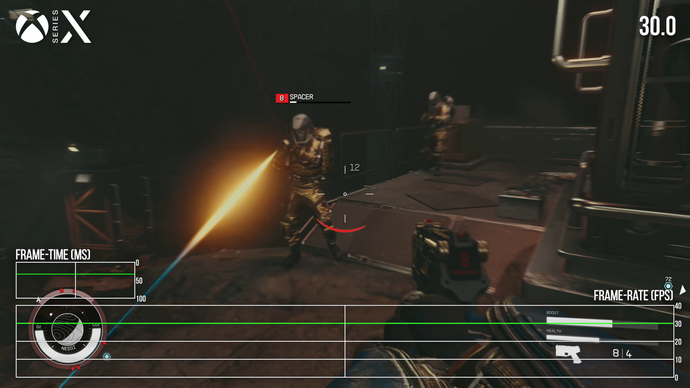
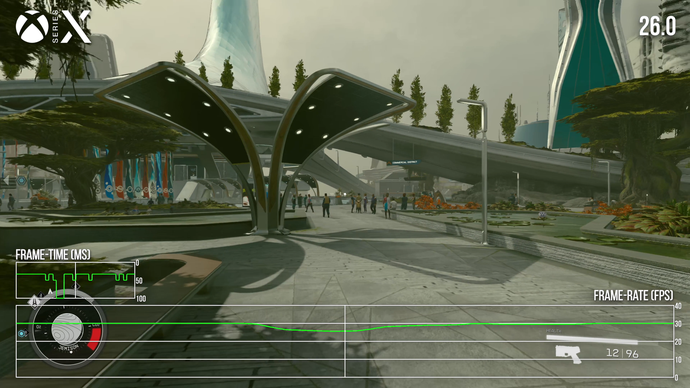
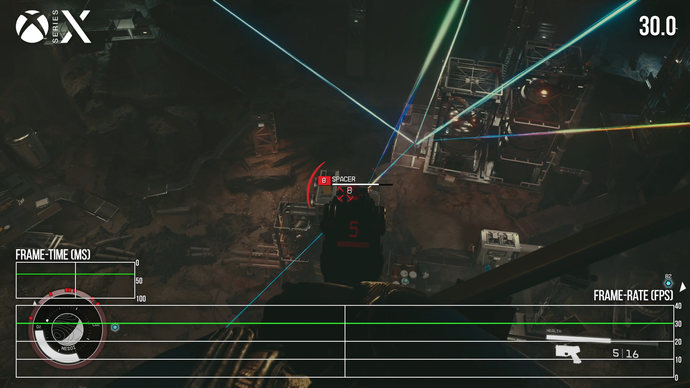
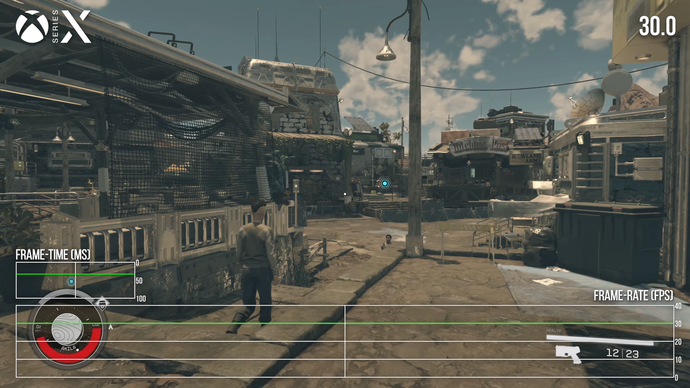
Testing with the day one patch installed, the good news is that overall gameplay is surprisingly solid. Starfield basically hits a locked 30fps for just about everything you do during the game. Combat is rock-solid, as is exploring the various planets. You can throw some pretty intense combat in large, open environments at the game and there are no performance issues to speak of whatsoever. This applies equally to both Series S and X, which perform identically here.
That said, there is one substantial caveat. Two of the game’s cities – namely New Atlantis and Akila – are prone to occasional performance problems. When running around these areas, there are a smattering of dropped frames, including some significant stutter. Most of the time these areas run just fine at 30fps, but there are issues for sure. New Atlantis seems to be the most impacted in my experience, which makes sense as it is the largest city area available in Starfield. I also recorded a couple of one second pauses – once on both Xbox consoles – while traversing the New Atlantis spaceport. It was pretty egregious, but this was the absolute worst I saw during my time with Starfield.
So, Starfield performs well enough, especially judged by the standards of Bethesda’s prior efforts. Outside of occasional issues in cities, the game delivers a very solid 30fps update with consistent frame-pacing. That 30fps frame-rate target is probably going to earn a bit of ire from players, but given the complexity of the world, as well as the CPU-heavy performance profile of the PC version, the 30fps target is totally understandable. The motion blur also helps to smooth out the 30fps update to some degree, and renders with a high sample count and no apparent artifacting. I do wish that this had an option to lengthen the virtual shutter speed a bit though for a more pronounced effect, as the blur tends to be a bit subtle at the moment. And for those who don’t like the effect, it can be turned off in the game’s settings.
From a technical perspective, Starfield is probably the most polished RPG that Bethesda has ever shipped. It’s largely a bug-free experience that proceeds with mostly unblemished performance and it looks great to boot. Bethesda’s games are massive titles with a ton of complexity and potential interactions and getting the game to this level of polish at launch is an impressive achievement. You get the sense that the game’s ten month delay likely helped significantly on this front.

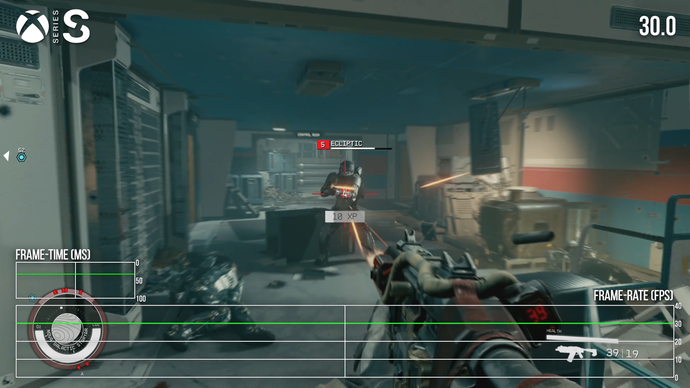
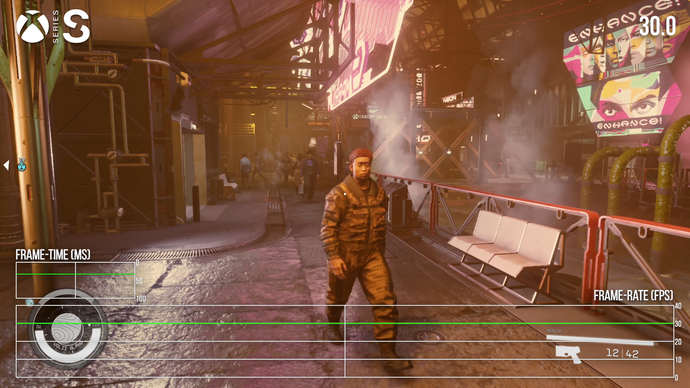
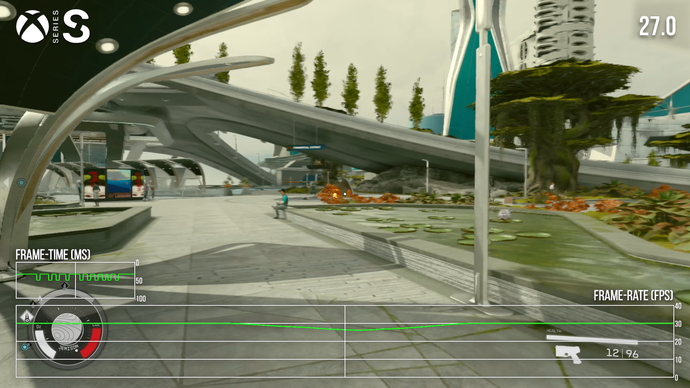
The game itself is also very good. This is more or less the game as advertised – a massive Bethesda RPG that takes place over multiple star systems, in the vastness of space. It’s a lot like Fallout 4, or Skyrim, but instead of walking through a contiguous landmass you navigate the game largely through a planetary travel interface, à la Mass Effect 2 or Eve Online, between cities and landing zones.
Starfield’s scope is immense, though that does come with certain caveats. Planetary exploration isn’t terribly exciting, given the procedurally-generated landmasses with repeated content. If anything, I think a reduced scope might have helped deliver a more carefully curated experience in line with recent Bethesda fare. Savvy players will be able to navigate through the game’s main quests, faction quests, and other named quests while keeping their interaction with the procedurally-generated elements to a minimum, but I do think the typical one-map structure of prior Bethesda games is perhaps a better approach.
That said, I have really enjoyed my time with Starfield and I’m bound to play it quite a bit more as the year closes out. It’s a super polished, genuinely fun Bethesda RPG. Even the combat feels great and the main content of the game is in very good form. It helps a lot that the typical advice when contemplating a new Bethesda RPG – to wait for bugs to be ironed out – doesn’t seem to apply here at all.
Starfield is a solid day one experience, with consistent performance and great visuals across both console platforms. Whether you’re gaming on Series S or Series X, Starfield arrives with solid, consistent performance and a level of polish that gives you the confidence to begin your journey right on day one.
- SEO Powered Content & PR Distribution. Get Amplified Today.
- PlatoData.Network Vertical Generative Ai. Empower Yourself. Access Here.
- PlatoAiStream. Web3 Intelligence. Knowledge Amplified. Access Here.
- PlatoESG. Automotive / EVs, Carbon, CleanTech, Energy, Environment, Solar, Waste Management. Access Here.
- PlatoHealth. Biotech and Clinical Trials Intelligence. Access Here.
- ChartPrime. Elevate your Trading Game with ChartPrime. Access Here.
- BlockOffsets. Modernizing Environmental Offset Ownership. Access Here.
- Source: https://www.eurogamer.net/starfield-launches-as-a-polished-consistent-experience-on-xbox-series-x-and-series-s
- 20
- 4k
- a
- able
- About
- Absolute
- accomplished
- achievement
- Achieves
- across
- Action
- actually
- Additionally
- advance
- Adventure
- advice
- All
- almost
- also
- always
- amazing
- AMD
- an
- and
- animations
- Another
- any
- Anything
- apparent
- apply
- approach
- ARE
- AREA
- areas
- around
- article
- artwork
- as
- At
- Atlantis
- attractive
- available
- bad
- bandwidth
- base
- basic
- BE
- beautiful
- become
- been
- begin
- BEST
- Bethesda
- Better
- between
- beyond
- BIG
- Bit
- both
- bound
- broad
- bugs
- but
- button
- by
- came
- CAN
- carefully
- causing
- Centre
- certain
- certainly
- change
- check
- Cities
- City
- close
- closely
- combat
- combining
- come
- comes
- comparing
- comparison
- complexity
- concerns
- concession
- confidence
- considering
- consistent
- Console
- Consoles
- content
- controversy
- conventional
- cookie
- cookies
- could
- couldn
- Counterpart
- Couple
- course
- coverage
- covering
- curated
- Curious
- data
- day
- deeper
- definitely
- degree
- delay
- delayed
- delays
- deliver
- detail
- detailed
- details
- DID
- didn
- difference
- differences
- different
- direct
- distance
- Distant
- do
- does
- doesn
- don
- down
- draw
- dropped
- due
- During
- dynamic
- earlier
- Earn
- Effect
- effort
- efforts
- either
- elements
- enable
- enjoyed
- enormous
- enough
- entire
- environmental
- environments
- equally
- especially
- even
- EVER
- Every
- everything
- evident
- exactly
- Example
- Exciting
- expect
- expectations
- experience
- exploration
- explore
- Exploring
- faces
- fallout
- Fallout 4
- far
- Features
- few
- fewer
- Final
- fine
- First
- First Look
- flaws
- Flexibility
- follows
- For
- form
- frequently
- from
- front
- fun
- game
- gameplay
- Games
- Gaming
- GDPR
- generally
- Get
- getting
- give
- given
- gives
- glance
- go
- going
- good
- GPU
- graphics
- grass
- great
- grew
- Ground
- Group
- had
- half
- has
- Have
- help
- helped
- helps
- here
- High
- higher
- highly
- hits
- hold
- holds
- hours
- How
- however
- HTTPS
- huge
- Hundreds
- i
- if
- image
- immense
- Impact
- impressive
- in
- in-game
- Including
- incredible
- indicated
- inFamous
- info
- initial
- instead
- interaction
- interactions
- interface
- internally
- interrupted
- into
- Is
- isn
- issue
- issues
- IT
- ITS
- itself
- JavaScript
- Job
- john
- journey
- judged
- just
- keeping
- Key
- kind
- knowledge
- known
- LA
- Landing
- large
- largely
- larger
- largest
- later
- latest
- launch
- launches
- less
- Level
- like
- likely
- Line
- location
- locked
- Look
- looking
- looks
- lot
- Low
- machine
- Machines
- main
- major
- make
- MAKES
- manage
- many
- Maps
- margin
- mass
- mass effect
- Mass Effect 2
- massive
- me
- means
- memory
- Message
- Microsoft
- might
- mind
- minimum
- mix
- moment
- Month
- more
- most
- mostly
- much
- multiple
- my
- named
- namely
- navigate
- Near
- New
- news
- no
- not
- notice
- obvious.
- Obviously
- of
- off
- offer
- Offers
- often
- on
- once
- One
- online
- only
- open
- Option
- Options
- or
- order
- orders
- Other
- otherwise
- our
- out
- output
- outside
- outstanding
- over
- overall
- particular
- pass
- Past
- Patch
- pause
- PC
- perform
- performance
- perhaps
- perspective
- pick
- picture
- place
- placement
- planets
- platform
- Platforms
- plato
- plato data intelligence
- platodata
- platogaming
- play
- player
- players
- Playing
- plays
- please
- polish
- poor
- possible
- post-processing
- potential
- practice
- pretty
- prior
- probably
- problems
- proceeds
- Produce
- Product
- Profile
- promises
- pronounced
- prospective
- PS3
- quality
- quarter
- question
- quests
- quite
- range
- RE
- reaching
- real-time
- really
- receiving
- recent
- recorded
- Reduced
- reduction
- Reflections
- RELATED
- release
- rendering
- resolution
- Resolve
- result
- review
- right
- Rock
- Rocky
- RPG
- RPGs
- Run
- running
- runs
- s
- Said
- same
- save
- savvy
- saw
- say
- scope
- seamless
- second
- see
- seem
- seems
- seen
- sees
- sense
- Series
- set
- settings
- several
- Shadow
- shape
- Short
- shot
- should
- significant
- significantly
- similar
- Size
- Skyrim
- slightly different
- small
- smaller
- smooth
- So
- so Far
- solid
- some
- something
- Space
- speak
- speed
- split
- Spot
- spots
- stable
- standards
- Star
- Starfield
- still
- Stones
- Story
- structure
- struggling
- substantial
- suffered
- super
- sure
- Surface
- surprise
- system
- Systems
- takes
- Target
- targeting
- targets
- tech
- Technical
- Technology
- television
- ten
- tends
- Testing
- than
- that
- The
- The Game
- the world
- their
- themselves
- there
- These
- they
- think
- this
- those
- though
- Through
- time
- times
- Title
- titles
- to
- Todd Howard
- Ton
- too
- tools
- top
- topic
- totally
- travel
- trees
- true
- turned
- two
- typical
- typically
- underlying
- up
- upcoming
- Update
- updated
- use
- using
- various
- ve
- version
- versions
- very
- Virtual
- visuals
- wait
- walking
- was
- we
- Wealth
- well
- were
- What
- when
- where
- whether
- while
- WHO
- will
- window
- with
- without
- Work
- world
- worse
- worst
- worth
- would
- would give
- X
- xbox
- xbox series
- Xbox Series S
- Xbox Series X
- Xbox Series X and Series S
- year
- you
- your
- youtube
- zephyrnet

